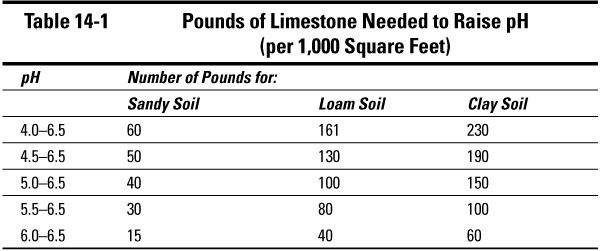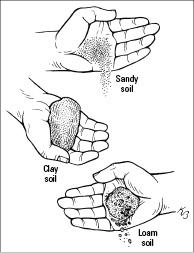Vegetable Gardening (96 page)

Figure 14-2:
Squeeze your soil to find out what type you have.
If you have sandy or clay soil, don't despair; you can improve your soil and make it more like loam. Check out the section "Adding organic matter (aka the dead stuff)," later in this chapter, for details.
Testing your soil
Vegetables are kind of picky about soil chemistry. Too much of this nutrient or too little of that nutrient, and you have problems. If you don't believe me, check out Chapter 4 to see what happens when tomatoes grow in soil that's deficient in calcium; they develop blossom-end rot. Yuck. Sometimes too much of a nutrient, such as nitrogen, causes lots of leaf growth on plants (such as peppers) but few fruits. Getting the levels just right is important for the best harvest.
In addition to nutrient levels, soil pH also is an important factor in plant growth. The right pH enables vegetables to use nutrients from the soil. Soil is rated on a pH scale, with a pH of 1 being most acidic and a pH of 14 being most alkaline. If your soil's pH isn't within a suitable range, plants can't take up nutrients — like phosphorus and potassium — even if they're present in the soil in high amounts. On the other hand, if the pH is too low, the solubility of certain minerals, such as manganese, may increase to toxic levels.
 Most vegetables grow well in a slightly acidic soil with a pH between 6 and 7. Potatoes, including sweet potatoes, prefer a slightly more acidic soil, in the 5 to 6 range. But in general, if you aim for a soil pH between 6 and 7, your vegetables should grow well.
Most vegetables grow well in a slightly acidic soil with a pH between 6 and 7. Potatoes, including sweet potatoes, prefer a slightly more acidic soil, in the 5 to 6 range. But in general, if you aim for a soil pH between 6 and 7, your vegetables should grow well.
The only way to find out whether your soil will be to your vegetables' liking is to test it. Don't worry; analyzing your soil isn't complicated, and you don't need a lab coat. Here are two ways that you can test your soil:
 Use a do-it-yourself kit.
Use a do-it-yourself kit.
This basic pH test measures your soil's acidity and alkalinity and sometimes major nutrient content. Buy a kit at a nursery, follow the instructions, and voilà — you know your soil's pH. However, the test gives you only a rough picture of the pH and nutrient levels in your soil. You may want to know more about your soil.
 Have a soil lab do a test for you.
Have a soil lab do a test for you.
A complete soil test is a good investment because a soil lab can thoroughly analyze your soil. Here's what you can find out from a soil lab's test in addition to the pH level:
•
Your soil's nutrient content.
If you know your soil's nutrient content, you can determine how much and what kind of fertilizer to use. In fact, many soil tests tell you exactly how much fertilizer to add; see Chapter 15 for more on fertilizer.
•
Soil problems that are specific to your geographic region.
A soil test may help you identify local problems. The soil lab should then give you a recommendation for a type and amount of fertilizer to add to your soil. For example, in dry-summer areas, you may have salty soil; the remedy is to add
gypsum,
a readily available mineral soil additive.
Of course, soil labs charge around $20 to $30 for their basic services. Your local Cooperative Extension Service office or a private soil lab can conduct a complete and reliable soil test. To locate a private lab, look in the phone book under
soil testing
(or search the Internet for soil test labs around the country). You also can ask your Cooperative Extension Service office for recommendations.
 Fall is a good time to test soil because labs aren't as busy. It's also a good time to add many
Fall is a good time to test soil because labs aren't as busy. It's also a good time to add many
amendments
(materials that improve your soil's fertility and workability) to your soil because they break down slowly.
To prepare a soil sample to use with a do-it-yourself kit or to send to a soil lab, follow these steps:
1. Fill a cup with soil from the top 4 to 6 inches of soil from your vegetable garden, and then place the soil in a plastic bag.
2. Dig six to eight similar samples from different parts of your plot.
3. Mix all the cups of soil together; place two cups of the combined soil in a plastic bag — that's your soil sample.
After you've collected your sample, consult the instructions from your soil test kit or the testing lab.
 If you're testing a soil imbalance — a known problem that you've identified in either pH or nutrients — you may want to test your soil every year because changes in pH and most nutrients are gradual. A home testing kit is a good way to test a pH imbalance. For nutrients, you may want to do a yearly test at a lab until the imbalance (high or low levels of a nutrient) is fixed. To maintain balanced soil, test it every 3 to 5 years.
If you're testing a soil imbalance — a known problem that you've identified in either pH or nutrients — you may want to test your soil every year because changes in pH and most nutrients are gradual. A home testing kit is a good way to test a pH imbalance. For nutrients, you may want to do a yearly test at a lab until the imbalance (high or low levels of a nutrient) is fixed. To maintain balanced soil, test it every 3 to 5 years.
Adjusting soil pH
Most garden soils have a pH between 5.5 and 8.0. This number helps you determine when and how to adjust your soil's pH level. The following guidelines help you interpret this number:
 If the number is below 6, the soil is too acidic, and you need to add ground limestone.
If the number is below 6, the soil is too acidic, and you need to add ground limestone.
 If the measurement is above 7.5, the soil is too alkaline for most vegetables, and you need to add soil sulfur.
If the measurement is above 7.5, the soil is too alkaline for most vegetables, and you need to add soil sulfur.
In the following sections, I explain how to figure out how much lime or sulfur you need to add to your soil and how to apply the materials.
Calculating how much lime or sulfur you need
All Cooperative Extension Service offices, any soil lab, and many lawn and garden centers have charts showing how much lime or sulfur to add to correct a pH imbalance. The charts tell you how many pounds of material to add per 1,000 square feet, so you need to measure the size of your vegetable garden first. Then use Tables 14-1 and 14-2 to figure out how much lime or sulfur you need to add to your soil.


